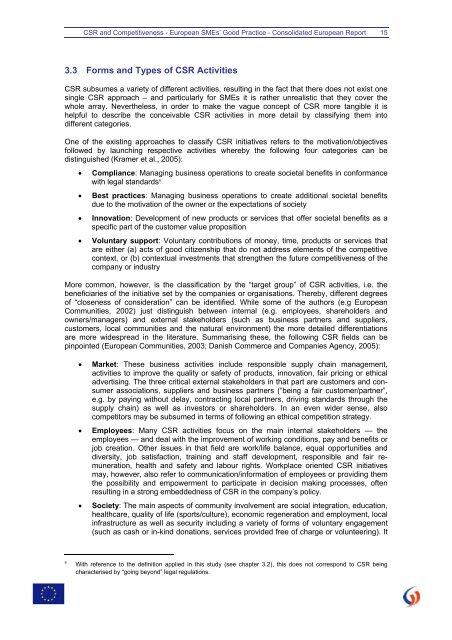CSR and Competitiveness European SMEs - KMU Forschung Austria
CSR and Competitiveness European SMEs - KMU Forschung Austria
CSR and Competitiveness European SMEs - KMU Forschung Austria
You also want an ePaper? Increase the reach of your titles
YUMPU automatically turns print PDFs into web optimized ePapers that Google loves.
<strong>CSR</strong> <strong>and</strong> <strong>Competitiveness</strong> - <strong>European</strong> <strong>SMEs</strong>’ Good Practice - Consolidated <strong>European</strong> Report 15<br />
3.3 Forms <strong>and</strong> Types of <strong>CSR</strong> Activities<br />
<strong>CSR</strong> subsumes a variety of different activities, resulting in the fact that there does not exist one<br />
single <strong>CSR</strong> approach – <strong>and</strong> particularly for <strong>SMEs</strong> it is rather unrealistic that they cover the<br />
whole array. Nevertheless, in order to make the vague concept of <strong>CSR</strong> more tangible it is<br />
helpful to describe the conceivable <strong>CSR</strong> activities in more detail by classifying them into<br />
different categories.<br />
One of the existing approaches to classify <strong>CSR</strong> initiatives refers to the motivation/objectives<br />
followed by launching respective activities whereby the following four categories can be<br />
distinguished (Kramer et al., 2005):<br />
• Compliance: Managing business operations to create societal benefits in conformance<br />
with legal st<strong>and</strong>ards 9<br />
• Best practices: Managing business operations to create additional societal benefits<br />
due to the motivation of the owner or the expectations of society<br />
• Innovation: Development of new products or services that offer societal benefits as a<br />
specific part of the customer value proposition<br />
• Voluntary support: Voluntary contributions of money, time, products or services that<br />
are either (a) acts of good citizenship that do not address elements of the competitive<br />
context, or (b) contextual investments that strengthen the future competitiveness of the<br />
company or industry<br />
More common, however, is the classification by the “target group” of <strong>CSR</strong> activities, i.e. the<br />
beneficiaries of the initiative set by the companies or organisations. Thereby, different degrees<br />
of “closeness of consideration” can be identified. While some of the authors (e.g <strong>European</strong><br />
Communities, 2002) just distinguish between internal (e.g. employees, shareholders <strong>and</strong><br />
owners/managers) <strong>and</strong> external stakeholders (such as business partners <strong>and</strong> suppliers,<br />
customers, local communities <strong>and</strong> the natural environment) the more detailed differentiations<br />
are more widespread in the literature. Summarising these, the following <strong>CSR</strong> fields can be<br />
pinpointed (<strong>European</strong> Communities, 2003; Danish Commerce <strong>and</strong> Companies Agency, 2005):<br />
• Market: These business activities include responsible supply chain management,<br />
activities to improve the quality or safety of products, innovation, fair pricing or ethical<br />
advertising. The three critical external stakeholders in that part are customers <strong>and</strong> consumer<br />
associations, suppliers <strong>and</strong> business partners (“being a fair customer/partner”,<br />
e.g. by paying without delay, contracting local partners, driving st<strong>and</strong>ards through the<br />
supply chain) as well as investors or shareholders. In an even wider sense, also<br />
competitors may be subsumed in terms of following an ethical competition strategy.<br />
• Employees: Many <strong>CSR</strong> activities focus on the main internal stakeholders — the<br />
employees — <strong>and</strong> deal with the improvement of working conditions, pay <strong>and</strong> benefits or<br />
job creation. Other issues in that field are work/life balance, equal opportunities <strong>and</strong><br />
diversity, job satisfaction, training <strong>and</strong> staff development, responsible <strong>and</strong> fair remuneration,<br />
health <strong>and</strong> safety <strong>and</strong> labour rights. Workplace oriented <strong>CSR</strong> initiatives<br />
may, however, also refer to communication/information of employees or providing them<br />
the possibility <strong>and</strong> empowerment to participate in decision making processes, often<br />
resulting in a strong embeddedness of <strong>CSR</strong> in the company’s policy.<br />
• Society: The main aspects of community involvement are social integration, education,<br />
healthcare, quality of life (sports/culture), economic regeneration <strong>and</strong> employment, local<br />
infrastructure as well as security including a variety of forms of voluntary engagement<br />
(such as cash or in-kind donations, services provided free of charge or volunteering). It<br />
9<br />
With reference to the definition applied in this study (see chapter 3.2), this does not correspond to <strong>CSR</strong> being<br />
characterised by “going beyond” legal regulations.




